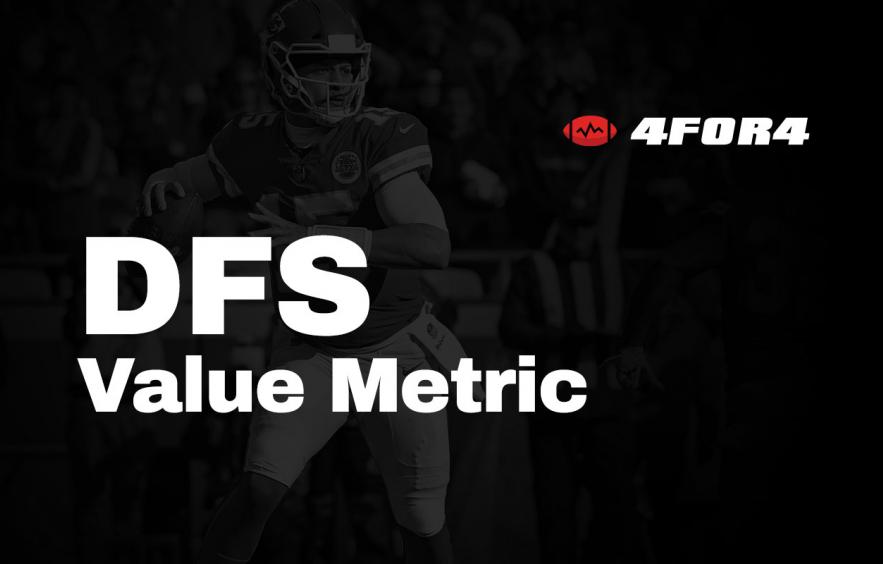Dfs Value Formula
Bankroll management is one of the hardest parts of drafting a strong daily fantasy football team is appropriating the right amount of salary dollars to the right players. One of the simplest ways to determine how much salary should be devoted to a specific roster slot on your team is to look at the number of salary dollars per fantasy point ($/FP) you should expect from a player. This is still a complex method, and in order to get good results from it, you should definitely understand the math behind the process first.
Intrinsic Value: Projected FCF = ( Growth Multiple. Free Cash Flow (6 year avg) + Total Stockholders Equity (most recent) / 0.8 ) / Shares Outstanding (Diluted Average) Add all the Free Cash Flow together and divide 6 will get Discover Financial Services's Free Cash Flow (6 year avg) = $4,688.17. Discover Financial Services (DFS) Value Grade and underlying metrics. PE ratios, EBITDA, EPS, cash flow, ROE. Compare with other.
DSF Formula delivers nutrients like: Tyrosine‚ which is a precursor to the thyroid’s adrenocortical hormones‚ as well as to the neurotransmitter dopamine. Magnesium‚ which is critical to the proper functioning of nerves and muscles.
Before we start looking at $/FP data, you should have a good idea of how many fantasy points you need in order to place in the money in your league. Looking at 50/50 leagues is a good place to start as all of the prize money is the same in these, and they are fairly easy to win a prize in. Other leagues, such as tournaments, will obviously have a different approach to them.
If you have determined that you need to score 125 fantasy points in your daily football league to secure a cash prize, then you start with this number, and then break each roster slot down into segments. You should aim for more than the 125 points to give yourself a better chance of winning and think of it as more of a bare minimum to achieve. If in this league, your QB is projected to achieve 15 points, then you take the 15 points and figure out what percentage of 125 it is. In this instance, it’s 12 percent. If you have $50,000 of salary to work with, then 12 percent of $50,000 is $6,000. So, this is the correct amount to spend on QB if he is going to give you 15 points. You can break each position down like this, and as long as your projected point total is above 125, then you have a good chance of finishing in the money in your 50/50 league.
The hard part is spreading your salary around so that you can get your total up above that magic number. In order to do this, the best way for you determine this is with the concept of value. And to determine this, we go back to $/FP.
In short, the best way to find a high value player is to find a player with as small of a $/FP number as possible. If Antonio Brown has a salary of $7,000 and is projected to score 18 points, then his $/FP number equals 7,000/18, or $389/FP. That’s not a bad number, but if Odell Beckham, Jr. has a salary of $6,800 and is projected to score 17.9 points, then his $/FP equals $380/FP, which is slightly better. You are spending less money and you are projected to get a smaller return, but the amount that you are spending per point here is better. Stretching this concept across your entire lineup will allow you to spend less and still make sure that you are getting the best value out of every player on your roster, whether they are one of your top picks or not.
When you take this concept to the larger tournaments, where your payout is determined by how high up you finish, this concept gets a bit tougher to understand, but is still applicable. Your goal is now not just to finish in the top 50 percent, but to finish as close to number one as possible. To figure this out, you need to look at recent results in similar leagues. Let’s say that over the past 100 similar tournaments, an average winning score of 210 has occurred. Now, you just need to adapt the numbers on your roster to add up to as close to this number as possible. That’s not likely to occur with just projections, so you will find yourself taking a few risks here and there. This is where daily fantasy sports become less of a science and more of an art form. Our suggestion? Find cheaper players that have high ceilings, and mix them in with your more stable and consistent players.
How the Pros Make Money Playing Daily Fantasy Football (FanDuel & DraftKings)
Understanding Site Salaries
The ability to determine a players value vs their point production (output) is what separates the professional Daily fantasy football players that are making money playing Fanduel and Draftkings vs those who are losing money.
Fantasy football is a game based on risk and reward. A player’s value can only be determined by their expected production exceeding the cost to draft them. There is no way to determine “value” without some idea of the cost.
It’s no different than your season long fantasy league; the cost would be a player’s average draft position. In daily fantasy, the cost is much easier to understand. Every DFS site whether its FanDuel or DraftKings, provides salaries for each player, and only way to determine a players value is by comparing a player’s salary vs his anticipated production.
After all, the actual production you receive from a player is not as important as the production you receive relative to his salary. That’s why daily fantasy players create spreadsheets to determine a player’s actual value by their cost per-point of production to figure out which players are the best values and how to best optimize lineups. Player salaries are an absolutely vital aspect of understanding value.
What do I mean by cost per point of production?
For example in your season long league, if you drafted Mike Evans in round 5 and he gets you 160 fantasy points this year or Vincent Jackson in round 3 and he gets you 170 fantasy points, who is the better value? Clearly Mike Evans is the better value. Daily fantasy football is no different, except every week we need to know which player will give us the most production for their designated salary.
In daily fantasy sports, if you draft Aaron Rodgers at a cost of $9900 and you project he will get you 30 points or Matt Ryan for $6000 and you project he will get you 20 points, who is the better value?

To calculate a price of a players point of production we divide a players salary by the projected points we think a player will score.
Aaron Rodgers $9,900/30(pts)= $330 per point of production
Matt Ryan $6,000/20(pts) = $300 per point of production
Clearly Matt Ryan is the better option for two reasons. First, he costs less per point of production and second, selecting Ryan for you lineup saves you $3,900 in cap space. That’s HUGE when you only have $60,000 cap space to spend on FanDuel and $50,000 cap space available to spend on DraftKings.
Why is this great when Rodgers will score more points?
Dfs Value Formula
Because using Rodgers gives you less to spend on other player positions. This means you will be sacrificing production in other positions because you can only afford lesser quality players.
Selecting Ryan gives you allows you to select a stud wide receiver or running back in you lineup that will make up the production lost between Rodgers and Ryan.
Another point Daily Players consider is a players ceiling vs their floor. What that means is Rodgers floor is lowest points you expect Rodgers to score and his ceiling is the most you think Rodgers will score. Now going back to our calculations what if Rodgers floor is 20 points and his ceiling is 30 points?


Rodgers $9,900/20 points = $495 per point!
If Rodgers doesn’t produce, your spending $495 per point and that is just too expensive and will cost you in other areas of your team. If Ryan gets his 20 points it only cost you $300 per point!
Determining Value Across Different Positions
I covered how to determine a players value based on the same position, but how do you tell if a players fantasy production value is worth the price across positions? If Gronk cost you $7,000 and Calvin Johnston costs you $9,500, who is more valuable?
Using All the Information Available to Make Your Selections
So why doesn’t everyone make and perform spreadsheet analysis?
For starters, it’s very time consuming to make a spreadsheet, entering each player’s name, their salary, coming up with their expected production, and then calculating their cost per point of production. Imagine doing that for every position? That’s why professional daily fantasy football players do this, because they make a living playing daily fantasy sports, so its worth it ot them to do this whereas the average person does not have the time to do this. Then after doing that you need time to perform the analysis
So how can the average guy even the odds and create a spreadsheet or obtain this player cost per point of production data?
Lockdown Corner now offers this salary vs projection price per point of production information. We can send you the most used players salaries on FanDuel and DraftKings. We calculate their production based on the average projected points by fantasy “gurus” and calculate the cost per point of production. Having this data allows you to turn your projections into value ratings without the hours’ worth of work involved
How to use Cost Per Point of Production Data?
Dfs Value Formula Cheat
I will get into this in another article. This data is a great guide for users but the human factor is still important in creating your teams. Knowing who is injured, who is starting, and strength of matchups are extremely important.